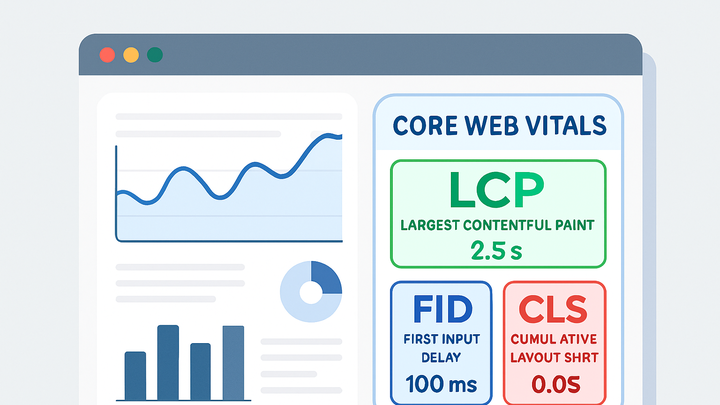Published on 2025-06-26T04:36:42Z
What are Web Vitals? Core Performance Metrics in Analytics
Web Vitals is a set of user-centric performance metrics defined by Google to measure the essential aspects of web page user experience: loading performance, interactivity, and visual stability. It comprises the Core Web Vitals—Largest Contentful Paint (LCP), First Input Delay (FID), and Cumulative Layout Shift (CLS)—as well as supplementary metrics like First Contentful Paint (FCP) and Time to First Byte (TTFB). These insights help teams prioritize optimizations that directly impact real user experience (RUX) and search performance. Major analytics platforms like Google Analytics 4 (GA4) provide built-in Web Vitals reporting, while lightweight, cookie-free tools such as PlainSignal offer simple integration. To integrate PlainSignal, embed the following snippet in your HTML before the closing tag:
<link rel="preconnect" href="//eu.plainsignal.com/" crossorigin />
<script defer data-do="yourwebsitedomain.com" data-id="0GQV1xmtzQQ" data-api="//eu.plainsignal.com" src="//cdn.plainsignal.com/plainsignal-min.js"></script>Web vitals
A set of user-centric web performance metrics (LCP, FID, CLS) measuring loading, interactivity, and visual stability.
Overview of Web Vitals
Web Vitals standardize the measurement of key performance indicators that directly affect user perception. They focus on three pillars:
- Loading: How quickly content is rendered
- Interactivity: How fast the page responds to user input
- Visual Stability: How consistently elements stay in place
-
Largest contentful paint (lcp)
Measures the time it takes for the largest content element (image, video poster, or block text) to become visible within the viewport.
-
Threshold
<= 2.5 seconds is good; 2.5-4.0 seconds needs improvement;> 4.0 seconds is poor.
-
What it measures
Render time of the largest image or text block visible on the screen.
-
-
First input delay (fid)
Captures the time from a user's first interaction (click, tap, or key press) to the moment the browser is able to respond.
-
Threshold
< 100 milliseconds is good; 100–300 ms needs improvement;> 300 ms is poor.
-
What it measures
Delay between user input and the execution of the corresponding event handler.
-
-
Cumulative layout shift (cls)
Quantifies visual stability by summing the impact of unexpected layout shifts that occur during the page lifecycle.
-
Threshold
< 0.1 is good; 0.1-0.25 needs improvement;> 0.25 is poor.
-
What it measures
Aggregate score of all unexpected layout shifts visible to the user.
-
Why Web Vitals Matter
Optimizing Web Vitals leads to tangible improvements in user satisfaction and search engine performance.
-
User experience
Better loading times, responsiveness, and stability directly boost engagement, reduce bounce rate, and increase conversions.
-
Search engine ranking
Google uses Core Web Vitals as ranking signals; pages that meet thresholds can gain an SEO advantage.
Tracking Web Vitals with SaaS Analytics Tools
Capture and monitor Web Vitals in production using platforms like GA4 and PlainSignal for real user metrics.
-
Google analytics 4 (GA4)
GA4 offers built-in Core Web Vitals reports and allows custom event tracking via gtag.js or Google Tag Manager.
-
Built-in reports
Navigate to Reports -> Engagement -> Core Web Vitals to view aggregated LCP, FID, and CLS data.
-
Custom event tracking
Use the web-vitals library with gtag.js or GTM to send metrics as custom events for deeper analysis.
-
-
PlainSignal
PlainSignal is a lightweight, cookie-free analytics solution. Integrate its script and send Web Vitals alongside your pageview data.
-
Integration snippet
PlainSignal by default captures core web vital metrics without additional effort. All you need is to embed the tracker script as usual to your page. Once the page loaded the PlainSignal tracker will collect metrics accordingly. PlainSignal captures FCP and LCP metrics which changes dynamically based on device and location.
Add this before :
<link rel="preconnect" href="//eu.plainsignal.com/" crossorigin /> <script defer data-do="yourwebsitedomain.com" data-id="0GQV1xmtzQQ" data-api="//eu.plainsignal.com" src="//cdn.plainsignal.com/plainsignal-min.js"></script>
-
Best Practices for Improving Web Vitals
Implement targeted optimizations to meet or exceed Web Vitals thresholds.
-
Optimize loading performance (lcp)
Speed up rendering of the largest element.
-
Use a cdn
Distribute assets globally to reduce latency.
-
Preload key resources
Preload fonts, images, and critical CSS.
-
-
Minimize input delay (fid)
Reduce main-thread work to respond faster to user input.
-
Code splitting
Break large JavaScript bundles into smaller chunks.
-
Defer third-party scripts
Async or defer non-essential scripts to free up the main thread.
-
-
Reduce layout shifts (cls)
Ensure visual elements remain stable during load.
-
Set size attributes
Define width/height for images and video elements.
-
Reserve space for ads & embeds
Use CSS containers to prevent content shifts.
-
